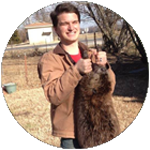MARK WEATHERFORD
Trapper and high school teacher

“Trapping is a way to cherish a natural resource that is so often forgotten.”
Mark Weatherford is a Kansas State University alumni who began trapping in 2011. Mark still resides in Kansas and is a high school Spanish teacher.
TruthAboutFur: How did you become a trapper? Tell us a little about yourself.
Mark Weatherford: I started trapping in 2011 after a friend in college had intrigued me with stories of his trapping endeavors growing up. As a person who loves the outdoors and old fashioned skills, I wanted to start trapping on my own so that I could tan my own pelts from the animals I trapped. I honestly was unaware of the fact that the State of Kansas still recognized fur harvesting. My appetite was wet and I started with one live trap and high hopes. I started small and worked my way up. A squirrel, some possums, a skunk and finally a raccoon. Fur harvesting and tanning the hides became my new hobby and the anticipation of checking traps in the morning was a thrill that hunting had never provided me. By the end of that first season I had made a quilted possum-fur baby blanket and a squirrel hat. My friends and family thought I had lost my mind, but I loved exploring this natural resource and appreciating the great outdoors that God gave us to enjoy.
TaF: What does trapping mean to you?
MW: I’m one of those people who you could say was born in the wrong era. I have never been in trapping for the money. I’ve never sold a pelt to dealer. I view trapping as a way to cherish a natural resource that is so often forgotten. Trapping and tanning hides isn’t just a great personal enjoyment, but it is a skill that could be essential to me and my family’s survival if 21st century technology and infrastructure ever fail us.
TaF: What are the benefits of trapping?
MW: There are several benefits.
- Behind every fur is a story; one that I can tell my children someday.
- To feel soft supple leather and fur that you’ve spent hours working with your hands from the time it was on the animal is a huge way to enjoy the fruit of your labor.
- You can sell furs to people have an interest in your work.
- Some people do sudoku and others crossword puzzles, but learning how to outwit that creature that takes your bait without getting caught sharpens your problem solving skills pretty quickly.
- It makes me appreciate the beauty God has given us in His creation.
Taf: Can you tell us about a typical day trapping?
MW: I never have a huge trapline. At most I have about 6 traps set per morning within a few square miles. I go out with my bucket and tools and set traps in the late afternoon before dusk. The next morning I go out from 6:30-8:00 and dispatch animals as I find them. They all go into the truck bed to be skinned later. I tend to any sets that had the bait taken, but didn’t go off or went off with no catch. When I get home I hang the animals in my barn and skin them “case” style. If it’s an animal that I think is worth eating (beaver, which tastes just like beef), I will gut it and cut it up for the freezer. The hide goes into the freezer for future home tanning projects.
Taf: What do you say to people who claim that “we don’t need trapping, because nature will take care of itself…”
MW: I haven’t had to deal with too many people arguing that trapping is a bad practice of wildlife management, but I do combat the claims that it’s just sick to kill innocent little animals for their skin. I tell them that all the animals are going to die. That beautiful animal could either die of natural cause and have it’s beautiful fur rot into the ground where no one will have ever appreciated it, or it can be preserved and appreciated for ages.
Taf: Would you encourage younger people to get into trapping?
MW: Yes! Since I don’t have children old enough to trap yet, I have invested in younger men in my life in the past. I’m a high school Spanish teacher who happened to get the school’s and parents’ permission to take a group of underclassmen trapping for the first time in their lives various weekends in the winter. It is a huge blessing to share that feeling of a first catch with somebody else. I look forward to doing the same with my children later.
I offer students the opportunity to learn how to turn a raw hide into a beautiful piece of leather and fur.






